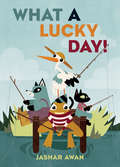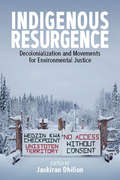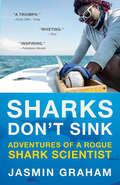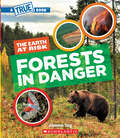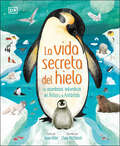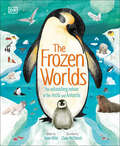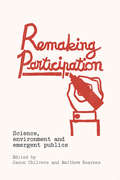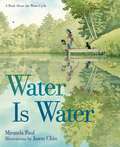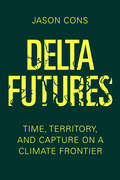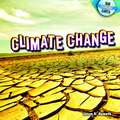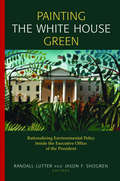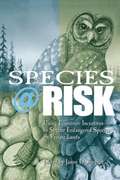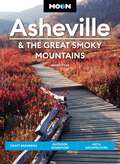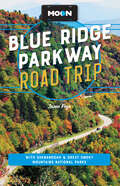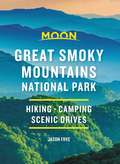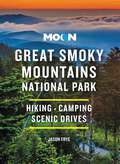- Table View
- List View
What a Lucky Day!
by Jashar AwanOH NO! BAD LUCK! A black cat crossed my path! I won’t catch anything today! Four animals are off to the lake to go fishing, but each thinks the other will wreck their day. Raccoons are thieves. Frogs give you warts. Storks deliver babies. Wait. What? Where did these crazy ideas come from? As this wryly humorous and thoroughly satisfying tale shows, it’s a mistake to judge others on what you’ve heard—and there’s plenty of luck for everyone.
Indigenous Resurgence: Decolonialization and Movements for Environmental Justice
by Jaskiran DhillonFrom the Standing Rock Sioux Tribe’s resistance against the Dakota Access pipeline to the Nepalese Newar community’s protest of the Fast Track Road Project, Indigenous peoples around the world are standing up and speaking out against global capitalism to protect the land, water, and air. By reminding us of the fundamental importance of placing Indigenous politics, histories, and ontologies at the center of our social movements, Indigenous Resurgence positions environmental justice within historical, social, political, and economic contexts, exploring the troubling relationship between colonial and environmental violence and reframing climate change and environmental degradation through an anticolonial lens.
Sharks Don't Sink: Adventures of a Rogue Shark Scientist
by Jasmin GrahamThe uplifting story of a young Black scientist&’s challenging journey to flourish outside the traditional confines of academia, inspired by her innate connection to nature&’s most misunderstood animal—the shark."Jasmin Graham has that winning combination of talent and grit needed to excel as a scientist. Every girl who wants to be a marine biologist should have this book." —Hope Jahren, New York Times bestselling author of Lab Girl and The Story of MoreSharks have been on this planet for over 400 million years, so there is a lot they can teach us about survival and adaptability. For example: how do sharks, which unlike other fish are denser than water, stay afloat? They keep moving. When Jasmin Graham, an award-winning young shark scientist, started to feel that the traditional path to becoming a marine biologist was pulling her under, she remembered this important lesson: keep moving forward.If navigating the choppy waters of traditional academic study was no longer worth it, then that meant creating an ocean of her own. Jasmin joined with three other Black women to form Minorities in Shark Sciences (MISS), an organization dedicated to providing support and opportunities for other young women of color. She became an independent researcher: a rogue shark scientist, seeking ways to keep these extraordinary endangered creatures swimming free—just like her.Sharks Don&’t Sink is a riveting, moving, and ultimately triumphant memoir at the intersection of science and social justice: a guidebook to how we can all learn to respect and protect some of nature&’s most misunderstood and vulnerable creatures—and grant the same grace to ourselves.
The Global Climate Regime and Transitional Justice (Routledge Advances in Climate Change Research)
by Jasmina Brankovic Sonja KlinskyGeopolitical changes combined with the increasing urgency of ambitious climate action have re-opened debates about justice and international climate policy. Mechanisms and insights from transitional justice have been used in over thirty countries across a range of conflicts at the interface of historical responsibility and imperatives for collective futures. However, lessons from transitional justice theory and practice have not been systematically explored in the climate context. The comparison gives rise to new ideas and strategies that help address climate change dilemmas. This book examines the potential of transitional justice insights to inform global climate governance. It lays out core structural similarities between current global climate governance tensions and transitional justice contexts. It explores how transitional justice approaches and mechanisms could be productively applied in the climate change context. These include responsibility mechanisms such as amnesties, legal accountability measures, and truth commissions, as well as reparations and institutional reform. The book then steps beyond reformist transitional justice practice to consider more transformative approaches, and uses this to explore a wider set of possibilities for the climate context. Each chapter presents one or more concrete proposals arrived at by using ideas from transitional justice and applying them to the justice tensions central to the global climate context. By combining these two fields the book provides a new framework through which to understand the challenges of addressing harms and strengthening collective climate action. This book will be of great interest to scholars and practitioners of climate change and transitional justice.
Forests in Danger (A True Book (Relaunch))
by Jasmine TingDiscover the rich biodiversity of Earth's biomes - and how they might be saved - with this STEAM-based subset of True Books.Did you know that forests contain many plant and animal species that are still unknown to science? This leafy biome is also a key to slowing climate change! Get ready to investigate Earth's wildly diverse forest ecosystems, as well as the plants and animals that have adapted to survive in them. You'll also learn about the many threats facing this fascinating biome - and what each of us can do to help - all in the pages of Forests in Danger.ABOUT THE SERIES:There are five major biomes on Earth: desert, forest, grassland, aquatic, and tundra. These rich, wild places are home to a wide variety of plants and animals - many of which are found nowhere else. Unfortunately, these ecosystems have been put at risk by human activities. This STEAM-based set of True Books introduces students to the incredible biodiversity of Earth's amazing biomes, as well as the threats they face in the era of climate change. Interesting information is presented in a fun, friendly way - and in the simplest terms possible - and will inspire kids to think about how they can help stop the destruction of Earth's wild spaces.
Green Energy (A True Book (Relaunch))
by Jasmine TingEnvision a brighter future with this STEM-based subset of True Books.We use a lot of energy to power our lives = from our homes and cars to our tablets and handheld games. The challenge facing us today is finding sustainable energy methods that will ensure a green future. There are seven different types of green energy = and they are the only types that don't pollute our Earth. We have learned how to harness the power of the sun, wind, water, and Earth. And technological innovations have allowed us to put these alternative energies to work in our everyday lives. Green Energy will show you how.ABOUT THE SERIES:What would a green future look like? Will trains and airplanes be powered by the sun? Will we have homes that have zero impact on the environment? The most pressing challenge facing us today is how to ensure a healthy Earth for ourselves and future generations. This STEM-based set of A True Books introduces students to the engineering innovations that can help us reach those goals. Interesting information is presented in a fun, friendly way = and in the simplest terms possible = and will inspire kids to start envisioning and enacting a more sustainable future.
La vida secreta del hielo (The Magic and Mystery of the Natural World)
by Jason BittelAdéntrate en 'La vida secreta del hielo' y embarca en un viaje increíble por los polos de la tierra.Osos polares, pingüinos y hielo se deslizan por las páginas de este colorido libro, que combina hermosas ilustraciones y fotos para ayudar a los niños más entusiastas a aprenderlo todo sobre el Ártico y la Antártida. Desde ríos helados hasta volcanes antárticos, descubrirán la increíble vida secreta de las regiones polares de la Tierra. También descubrirán cómo pueden ayudar a cuidar el Ártico y la Antártida.'La vida secreta del hielo' lleva a los niños por un deslumbrante viaje bajo cero, mostrándoles cuán increíbles son los polos de la tierra, qué plantas y animales viven cerca de ellos y cómo podemos ayudarlos. Incluye una multitud de vida polar, además de datos sorprendentes sobre cómo se forman los icebergs, cómo los animales sobreviven en el frío helado y cómo los científicos estudian la Antártida.Enter the world of the Arctic and Antarctic for an incredible journey around Earth&’s icy poles.Polar bears, penguins, and ice glide across the pages of this colorful book, which combines gorgeous illustrations and photos to help young enthusiasts learn all about the Arctic and Antarctic. From icy rivers to Antarctic volcanoes, they&’ll discover the incredible secret life of Earth&’s polar regions. They&’ll also find out how they can help take care of the Arctic and Antarctic themselves.'La vida secreta del hielo' takes children on a fascinating sub-zero journey, showing them just how amazing Earth&’s poles are, which plants and animals live near them, and how we can help them. It includes a multitude of polar life, plus amazing facts on how icebergs are formed, how animals survive in the freezing cold, and how scientists study the Antarctic.
The Frozen Worlds: The Astonishing Nature of the Arctic and Antarctic (The Magic and Mystery of the Natural World)
by Jason BittelEnter the world of the Arctic and Antarctic, in this gorgeously illustrated book for young animal and conservation enthusiasts.Polar bears and penguins glide and whales and walruses dive across the pages of this colorful book, which takes children on a fascinating sub-zero journey of the amazing Earth&’s poles.The Frozen Worlds combines stunning illustrations and photos to help young enthusiasts aged 7-9 learn all about the Arctic and Antarctic. From incredible frozen rivers to Antarctic volcanoes, they&’ll discover the incredible secret life of Earth&’s polar regions, as well as which plants and animals live near them, and how they can protect them from the issues facing them today. Children will love finding out all about the different people who live and work here, and how they can help take care of the Arctic and Antarctic themselves.This fascinating book for children features: - Intriguing information about the Arctic and Antarctic, that supports and goes beyond the curriculum!- Factual, fascinating, and fun content - with detailed illustrations and photographs of animals, icebergs, and more.- An engaging mixture of stunning photography and detailed illustrations by Claire McElfatrick.- Exciting and unusual facts convey information about our amazing polar regions.The Frozen Worlds covers a wide range of exciting subjects about the polar regions, from their wildlife to their geography and history, including a multitude of polar life, amazing facts on how icebergs are formed, how animals survive in the freezing cold, and how scientists study the Antarctic. Children with an interest in the Earth&’s icy poles will love reading about the ecosystems, habitats and climates in these fascinating regions.
Remaking Participation: Science, Environment and Emergent Publics
by Matthew Kearnes Jason ChilversChanging relations between science and democracy – and controversies over issues such as climate change, energy transitions, genetically modified organisms and smart technologies – have led to a rapid rise in new forms of public participation and citizen engagement. While most existing approaches adopt fixed meanings of ‘participation’ and are consumed by questions of method or critiquing the possible limits of democratic engagement, this book offers new insights that rethink public engagements with science, innovation and environmental issues as diverse, emergent and in the making. Bringing together leading scholars on science and democracy, working between science and technology studies, political theory, geography, sociology and anthropology, the volume develops relational and co-productionist approaches to studying and intervening in spaces of participation. New empirical insights into the making, construction, circulation and effects of participation across cultures are illustrated through examples ranging from climate change and energy to nanotechnology and mundane technologies, from institutionalised deliberative processes to citizen-led innovation and activism, and from the global north to global south. This new way of seeing participation in science and democracy opens up alternative paths for reconfiguring and remaking participation in more experimental, reflexive, anticipatory and responsible ways. This ground-breaking book is essential reading for scholars and students of participation across the critical social sciences and beyond, as well as those seeking to build more transformative participatory practices.
Coral Reefs: A Journey Through an Aquatic World Full of Wonder (Into Reading, Trade Book #6)
by Jason ChinNIMAC-sourced textbook
Grand Canyon
by Jason ChinRivers wind through earth, cutting down and eroding the soil for millions of years, creating a cavity in the ground 277 miles long, 18 miles wide, and more than a mile deep known as the Grand Canyon. <p><p> Home to an astonishing variety of plants and animals that have lived and evolved within its walls for millennia, the Grand Canyon is much more than just a hole in the ground. Follow a father and daughter as they make their way through the cavernous wonder, discovering life both present and past. <p> Weave in and out of time as perfectly placed die cuts show you that a fossil today was a creature much long ago, perhaps in a completely different environment. Complete with a spectacular double gatefold, an intricate map and extensive back matter.
Water is Water: A Book about the Water Cycle
by Jason Chin Miranda PaulThis spare, poetic picture book follows a group of kids as they move through all the different phases of the water cycle. From rain to fog to snow to mist, talented author Miranda Paul and the always remarkable Jason Chin (Redwoods, Coral Reefs, Island, Gravity) combine to create a beautiful and informative journey in this innovative nonfiction picture book that will leave you thirsty for more.
A Song of Sun and Sky
by Jason CockcroftA seemingly endless road trip for Lula and her father only seems to get worse when the car breaks down in the middle of the desert. Things are too boring and too orange until Lula encounters a mysterious painter who shows her that the desert is full of so much more to explore. This is an exploration of color, lighting, and the magic of art and nature, filtered through the lens of a fictional interaction with the artist Georgia O'Keeffe. Learn about the colors you bring along everywhere you go.
Delta Futures: Time, Territory, and Capture on a Climate Frontier
by Jason ConsA free ebook version of this title is available through Luminos, University of California Press's Open Access publishing program. Visit www.luminosoa.org to learn more.Delta Futures explores the competing visions of the future that are crowding into the Bengal Delta's imperiled present and vying for control of its ecologically vulnerable terrain. In Bangladesh's southwest, development programs that imagine the delta as a security threat unfold on the same ground as initiatives that frame the delta as a conservation zone and as projects that see the delta's rivers and ports as engines for industrial growth. Jason Cons explores how these competing futures are being brought to life: how they are experienced, understood, and contested by those who live and work in the delta, and the often surprising entanglements they engender—between dredgers and embankments, tigers and tiger prawns, fishermen and forest bandits, and more. These future visions produce the delta as a "climate frontier," a zone where opportunity, expropriation, and risk in the present are increasingly framed in relation to disparate visions of the delta's climate-affected future.
Driven by Demand: How Energy Gets its Power
by Jimmy Y. Jia Jason CrabtreeEnergy plays a central role in shaping our society and infrastructure, making it increasingly important for today's leaders to understand the impact of energy decisions. Discussions about energy often neglect important historical lessons about previous energy transformations and provide inadequate consideration of context - Driven by Demand takes a fresh approach by exploring the emergence of energy systems, outcomes and priorities. It outlines select historical and current events, challenges, and developing energy trends using a range of case studies. Readers will gain foundational knowledge about energy flows and end-uses, helping them to become more conversant about energy outcomes and priorities. This accessible book paves the way for broader discussions about societal resilience, privacy, and security concerns associated with the move towards 'smart' infrastructure. This is a must-read for business executives, policymakers and students working in energy policy, energy management and sustainable business.
Climate Change
by Jason D. NemethOur home planet's climate has gone through tremendous changes during its history. This fascinating book discusses these changes, explains the processes that drove them, and describes the methods scientists use to learn about the history of Earth's climate. The volume also addresses the kinds of climate changes happening today and clarifies how these differ from changes that occurred in the past. The book's easy-to-follow language will make this complex topic easy for young readers to digest.
Painting the White House Green: Rationalizing Environmental Policy Inside the Executive Office of the President
by Jason F. Shogren Randall LutterPresidents, like kings, lead cloistered lives. Protecting the president from too much isolation are advisers and aides who help ensure that the administration achieves its policy goals while enjoying broad political support. In economics and environmental policy, where disagreement among stakeholders and expert opinion is especially strong, the president needs good advice about political strategy, as well as unbiased information about the substance of policy issues. It is the latter need that the Council of Economic Advisers (CEA) is intended to address. Painting the White House Green collects personal essays by eight Senior Staff Economists for Environmental and Natural Resource Policy who worked within the CEA from 1992 to 2002. These authors confirm the council's 'severe' view of many environmental initiatives, a perspective that led President Clinton to label his economic advisers as 'lemon suckers.' At the same time, they demonstrate that the emphasis on efficiency was to offer more effective environmental protection at lower cost. Thinking 'green' meant thinking consistently about both economics and the environment. The essays in this innovative book present lively debates on clean air, climate change, and electricity deregulation that pitted economists at CEA, the Office of Management and Budget, and often the Treasury Department, against political advisers in the White House and officials at EPA and other agencies. The essays present vivid portraits of the power plays involved in environmental policymaking, rare insights into presidential decisionmaking, and revealing details of the ways that economic thinking influences-or is neglected-in a wide range of policy decisions.
Private Property and the Endangered Species Act: Saving Habitats, Protecting Homes
by Jason F. Shogren William D. RuckelshausOur whole nation benefits from the preservation of natural habitats and their diversity of animal and plant species—yet small groups of private landowners often bear most of the costs of setting land aside for conservation purposes. This imbalance has generated many conflicts since the passage of the Endangered Species Act in 1973 and remains one of the most controversial issues to be resolved as the ESA makes its way through Congress for reauthorization.
Species at Risk: Using Economic Incentives to Shelter Endangered Species on Private Lands
by Jason F. ShogrenProtecting endangered species of animals and plants is a goal that almost everyone supports in principle--but in practice private landowners have often opposed the regulations of the Endangered Species Act, which, they argue, unfairly limits their right to profit from their property. <P><P>To encourage private landowners to cooperate voluntarily in species conservation and to mitigate the economic burden of doing so, the government and nonprofit land trusts have created a number of incentive programs, including conservation easements, leases, habitat banking, habitat conservation planning, safe harbors, candidate conservation agreements, and the "no surprise" policy.
Moon Asheville & the Great Smoky Mountains (Travel Guide)
by Jason FryeWhether you're hopping between microbreweries or hiking the Appalachian Trail, get to know this charming Southern hub with Moon Asheville & the Great Smoky Mountains. Inside you'll find:Flexible, strategic itineraries, from a weekend in Asheville to five days in Great Smoky Mountains National Park, designed for outdoor adventurers, foodies, history buffs, and moreThe best local flavor: Indulge in award-winning cuisine on a food tour, discover the microbreweries that earned Asheville the title of "Beer City USA," and catch a live show from a local band. Admire the art deco architecture downtown, gallery-hop in repurposed warehouses, or check out an indie bookstoreUnique outdoor experiences: Hike through the mountains and meadows along the Appalachian Trail, take a dip in the hot springs dotting the hillsides, or break out the binoculars for some top-notch wildlife-watching. Set up camp in the Pisgah National Forest, peep the changing leaves in autumn, or go rafting, kayaking, or canoeing on the French Broad RiverHonest advice on when to go, where to stay, and how to get around from North Carolina local Jason FryeFull-color photos and detailed maps throughoutThorough background on the culture and history, wildlife, and geographyHelpful tips for hikers and campers, LGBTQ+ travelers, and travelers with disabilitiesFind your adventure with Moon Asheville & the Great Smoky Mountains.Exploring more of the South? Try Moon Carolinas & Georgia. Looking for more Southern city charm? Try Moon Charleston & Savannah.
Moon Asheville & the Great Smoky Mountains: Craft Breweries, Outdoor Adventure, Art & Architecture (Travel Guide)
by Jason FryeWhether you're hopping between microbreweries or hiking the Appalachian Trail, get to know this charming Southern hub with Moon Asheville & the Great Smoky Mountains. Inside you'll find:Flexible, strategic itineraries, whether you have a week to explore or just one day, designed for outdoor adventurers, foodies, history buffs, and more The best local flavor: Indulge in award-winning cuisine on a food tour, discover the microbreweries that earned Asheville the title of "Beer City USA," and catch a live show from a local band. Admire the art deco architecture downtown, gallery-hop in repurposed warehouses, or check out an indie bookstore Unique outdoor experiences: Hike through the mountains and meadows along the Appalachian Trail, take a dip in the hot springs dotting the hillsides, or break out the binoculars for some top-notch wildlife-watching. Set up camp in the Pisgah National Forest, peep the changing leaves in autumn, or go rafting, kayaking, or canoeing on the French Broad River Honest advice on when to go, where to stay, and how to get around from North Carolina local Jason Frye Full-color photos and detailed maps throughoutThorough background on the culture and history, wildlife, and geography Find your adventure with Moon Asheville & the Great Smoky Mountains. Expanding your trip? Try Moon North Carolina. Looking for more Southern charm? Try Moon Charleston & Savannah. About Moon Travel Guides: Moon was founded in 1973 to empower independent, active, and conscious travel. We prioritize local businesses, outdoor recreation, and traveling strategically and sustainably. Moon Travel Guides are written by local, expert authors with great stories to tell—and they can't wait to share their favorite places with you. For more inspiration, follow @moonguides on social media.
Moon Blue Ridge Parkway Road Trip: With Shenandoah & Great Smoky Mountains National Parks (Travel Guide)
by Jason FryeFrom the sprawling green countryside of Shenandoah to the mists rising over the Great Smoky Mountains, endless adventure and beauty await along America's most scenic highway. Inside Moon Blue Ridge Parkway Road Trip you'll find:Multiple Routes: Choose from flexible getaways along the Blue Ridge Parkway, including the ultimate two-week route, a four-day loop from D.C., and more Eat, sleep, stop and explore: With lists of the best hikes, views, restaurants, and more, you can listen to live bluegrass, find the best barbecue around, or sip local moonshine. Wander through the renowned museums in Washington D.C. or take a break in a charming mountain town. Explore a labyrinthine cave system, hike a leg of the famous Appalachian Trail, and spot black bears and elk in Great Smoky Mountains National Park. Try your hand at gem mining, spend an afternoon antique hunting, or pick fruit at a family-owned orchard Maps and driving tools: Easy-to-use maps keep you oriented on and off the highway, along with site-to-site mileage, driving times, detailed directions, and full-color photos throughoutLocal expertise: North Carolinian and mountaineer Jason Frye shares his top tips for what to do Planning your trip: Know when and where to get gas, how to avoid traffic, tips for driving in different road and weather conditions, and suggestions for LBGTQ+ travelers, seniors, and road trippers with children With Moon Blue Ridge Parkway Road Trip's flexible itineraries and practical tips you're ready to fill up and hit the road. Exploring more of America on wheels? Try Moon Nashville to New Orleans Road Trip or Moon Drive & Hike Appalachian Trail. Doing more than driving through? Check out Moon Great Smoky Mountains National Park. About Moon Travel Guides: Moon was founded in 1973 to empower independent, active, and conscious travel. We prioritize local businesses, outdoor recreation, and traveling strategically and sustainably. Moon Travel Guides are written by local, expert authors with great stories to tell—and they can't wait to share their favorite places with you. For more inspiration, follow @moonguides on social media.
Moon Great Smoky Mountains National Park: Hike, Camp, Scenic Drives (Travel Guide)
by Jason FryeFrom majestic mountaintops to lush forests and untouched wilderness, take in the best of the Smokies with Moon Great Smoky Mountains National Park. Inside you'll find:Flexible Itineraries: Unique and adventure-packed ideas ranging from one day in the park to a week-long tripThe Best Hikes in the Great Smokies: Detailed hike descriptions with mileage, duration, elevation gains, and difficulty ratings, plus individual trail maps and options for backpackersExperience the Outdoors: Cruise along Newfound Gap Road for epic views from scenic overlooks and watch "smoky" mists rise up through the valleys. Spot local wildlife like 700-pound elk, black bears, and vast herds of white-tailed deer. Savor the refreshing solitude of a night camping under the stars or enjoy a twinkling light show from Elkmont's synchronous fireflies. Trek a segment of the Appalachian Trail, wander through remnants of the region's historic settlements, or try your hand at fly-fishingTake a Break: Unwind after a day of adventure at one of the trendy craft breweries that earned Asheville the title of "Beer City USA." Head to Dollywood for square-dancing, catching a show, or gliding down the lazy river at Splash Country. Soak in the sweet sounds of Tennessee's backwoods music scene, sample some fiery moonshine, or shop for crafty Appalachian folk artHow to Get There: Up-to-date information on gateway towns, park entrances, park fees, and toursWhere to Stay: Campgrounds, resorts, and more, both inside and outside the parkPlanning Tips: When to go, what to pack, safety information, and how to avoid the crowds, with full-color photos and detailed maps throughoutRecommendations for international visitors, travelers with disabilities, families, seniors, and LGBTQ+ travelersExpertise and Know-How: Explore the park with nature lover and Smoky Mountains expert Jason FryeFind your adventure in Great Smoky Mountains National Park with Moon.Hitting more of North America's national parks? Check out Moon USA National Parks. Road-tripping? Try Moon Drive & Hike Appalachian Trail or Moon Blue Ridge Parkway Road Trip.
Moon Great Smoky Mountains National Park: Hiking, Camping, Scenic Drives (Travel Guide)
by Jason FryeFrom majestic mountaintops to lush forests and untouched wilderness, experience the best of the Smokies with Moon Great Smoky Mountains National Park. Inside you'll find:Flexible itineraries: Unique and adventure-packed ideas ranging from one day in the park to a week-long trip The best hikes in the Great Smokies: Detailed hike descriptions with mileage, duration, elevation gains, and difficulty ratings, plus individual trail maps and options for backpackers Experience the outdoors: Cruise along Newfound Gap Road for epic views from scenic overlooks and watch "smoky" mists rise up through the valleys. Spot local wildlife like 700-pound elk, black bears, and vast herds of white-tailed deer. Savor the refreshing solitude of a night camping under the stars or enjoy a twinkling light show from Elkmont's synchronous fireflies. Trek a segment of the Appalachian Trail, wander through remnants of the region's historic settlements, or try your hand at fly-fishing Take a break: Unwind after a day of adventure at one of the trendy craft breweries that earned Asheville the title of "Beer City USA." Head to Dollywood for square-dancing, catching a show, or gliding down the lazy river at Splash Country. Soak in the sweet sounds of Tennessee's music scene, sample some fiery moonshine, or shop for Appalachian folk art How to get there: Up-to-date information on gateway towns, park entrances, and tours Where to stay: Campgrounds, resorts, and more, both inside and outside the park Helpful resources on Covid-19 and traveling to Great Smoky Mountains National Park Planning tips: When to go, what to pack, safety information, and how to avoid the crowds, with full-color photos and detailed maps throughoutExpertise and know-how: Explore the park with nature lover and Smoky Mountains expert Jason Frye Find your adventure in Great Smoky Mountains National Park with Moon. Hitting more of North America's national parks? Check out Moon USA National Parks. Road-tripping? Try Moon Drive & Hike Appalachian Trail or Moon Blue Ridge Parkway Road Trip. About Moon Travel Guides: Moon was founded in 1973 to empower independent, active, and conscious travel. We prioritize local businesses, outdoor recreation, and traveling strategically and sustainably. Moon Travel Guides are written by local, expert authors with great stories to tell—and they can't wait to share their favorite places with you. For more inspiration, follow @moonguides on social media.
